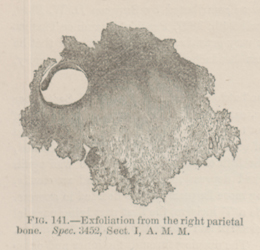Title: McK——, John
Source text: Surgeon General Joseph K. Barnes, United States Army, The Medical and Surgical History of the War of the Rebellion. (1861–65.), Part 1, Volume 2 (Washington, D.C.: Government Printing Office, 1870), 280.
Civil War Washington ID: med.d1e16936
TEI/XML: med.d1e16936.xml
CASE.—Private John McK——, Co. H, 105th Pennsylvania Volunteers, was wounded at Petersburg, Virginia, June 14th, 1864, by a conoidal musket ball, which struck the right side of the skull very obliquely, and produced a slightly depressed fracture of the right parietal bone. He was admitted to Mount Pleasant General Hospital, Washington, on June 24th, with the report that the progress of the case had been so far eminently satisfactory. After admission, he was found to be insensible, and a few hours subsequently, convulsions supervened in rapidly recurring paroxysms. Twelve ounces of blood were taken from the temporal artery without apparent benefit. A trephine was then applied to the seat of fracture, and, upon the removal of a button of bone, a portion of the inner table was found slightly depressed. This was elevated, and the patient soon afterward regained consciousness. On June 28th, the wound in the scalp became erysipelatous, and before the inflammation subsided, there was extensive loss of substance of the integuments and pericranium, denuding a large portion of the parietal bone. Necrosis ensued, and involved the whole thickness of the bone. On September 3d, 1864, a portion of the parietal, three inches by four, had become so much loosened that it was readily removed. Cicatrization then went on rapidly, and on December 2d, 1864, the wound had contracted to an ulcer less than an inch in diameter. The patient's mental faculties were impaired somewhat, the ward physician thought, but not to a great extent. A colored drawing was made representing the appearance of the parts prior to the separation of the exfoliation, No. 74, Surgical Series of Drawings, S. G. O., by Hospital Steward P. Baumgras, U. S. A. It is copied, in chromo-lithography, in the plate opposite page 207. The exfoliation, which was contributed, with a minute of the hospital record of the case, by Assistant Surgeon C. A. McCall, U. S. A., is represented in the accompanying wood-cut, taken from page 16 of Circular 6, S. G. O., 1865. The patient was discharged from service August 31st, 1864, and from the hospital February 1st, 1865. He was pensioned; the examiner, Dr. Julius Nichols, stating that he was totally disabled, and that the case was the most extraordinary that had come under his observation; the pulsations of the brain, uncovered by dura mater, and the trunk of the meningeal artery being distinctly visible. He went to his home in Montgomery County, Pennsylvania. In April, 1871, he wrote to the compiler of this volume as follows: * * "The space the bone was taken out of is three and a half by two inches. In feeling the place lightly, it goes all through my head. It is all healed over like a thin shell. I am compelled to lie on my left side when sleeping. When exposed to the sun a dull pain through my head is caused. * * I have received but seven dollars a month. My pension papers call for eight dollars."

